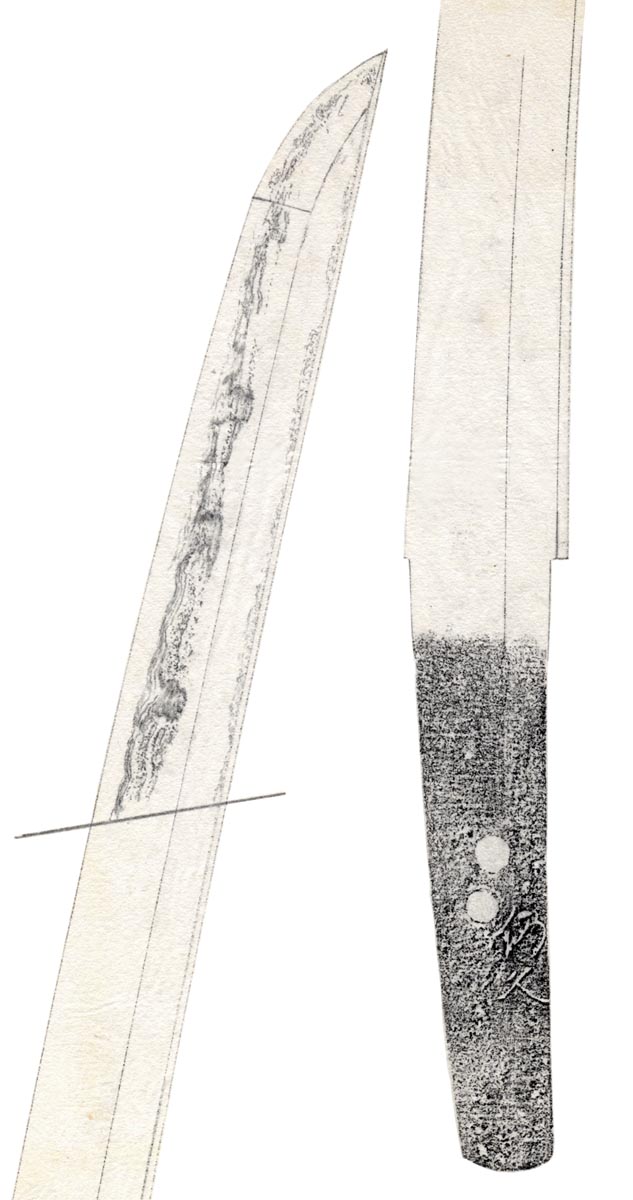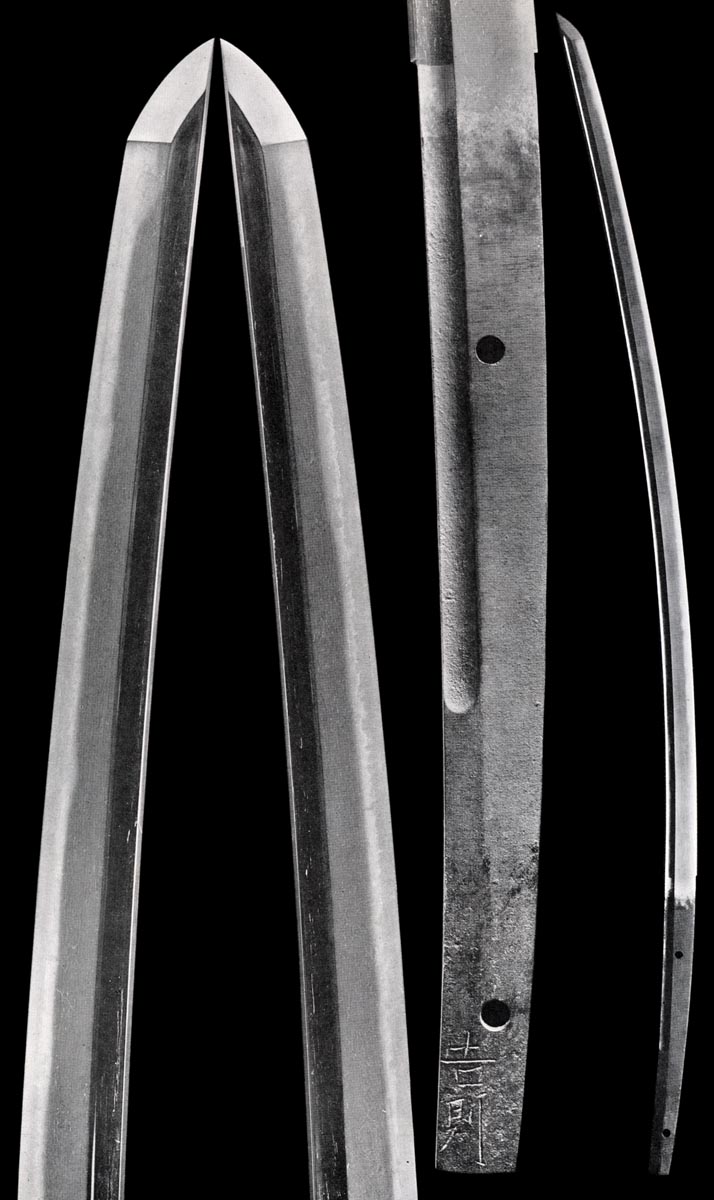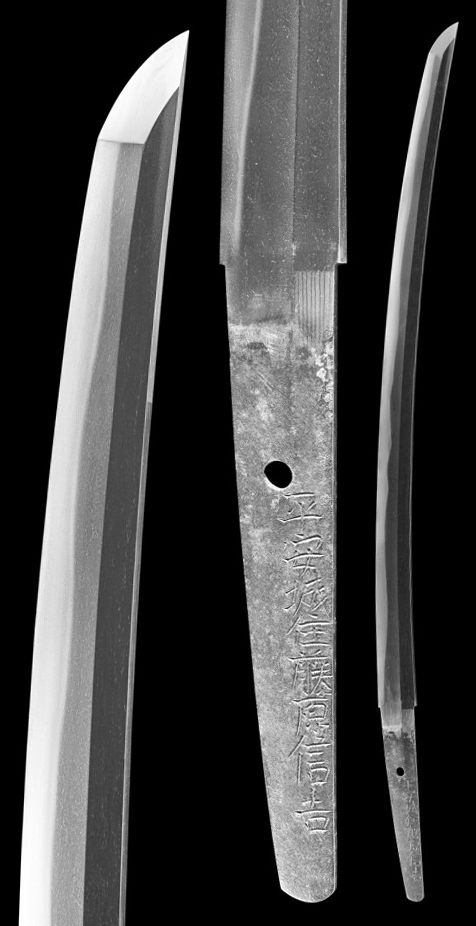| © Copyright Robert Cole 2015
- No copying or distributing - YAMASHIRO YAMASHIRO SANJO HEIANJO School |

|
 |
_______________
SANJO YOSHINORI(1) O-CHO 1311 - See SANJO
|__________________________
__________|____ ____|____
SANJO YOSHINORI(2) KEM-MU 1334 YOSHIHIRO GEN-TOKU 1329
__________|____
SANJO YOSHINORI(3) TEI-JI 1362 to EI-TOKU 1381
|_____________ _____________ ______________
__________|____ ____|____ ____|_____ ____|____
SANJO YOSHINORI(4) YOSHIMORI YOSHITSUGU(1) YOSHIHIRO
| - O-EI 1394 - | - O-AN 1368 -
__________|____ |______________
SANJO YOSHINORI(5) KYO-TOKU 1452 ____|_____ ____|_____
__________|____ YOSHITSUGU(2) SHIGETSUGU
SANJO YOSHINORI(6) BUN-MEI 1469 EI-KYO 1429 KA-KICHI 1441
|________________________
Famous for large KOSHIBA. Can be YAHAZU-MIDARE BA and HAKO-NOTARE BA, SENGO style. O-GUNOME MIDARE. May appear as rounded O-GUNOME grouped on a CHU-SUGU line. NAKAGO has the SENGO swelled belly to HA-side raised KURIJIRI. Many of the NAGA character of the 4th will seem halting. The horizontal bar of the NAGA and YOSHI tend to have ends where the right side is pointed down and the left, up. HEIANJO starts with MITSUNAGA's line creating foundations from which the SUGAWARA smiths take their place in O-EI. The O-NIN disintegrates YAMASHIRO as proud smiths keep their name through exile, spawning the eventual travels of NAGAYOSHI. BUN-GI is a forest of SENGOKU competitors finding main players such as SENGO MURAMASA, the SOSHU and SEKI, SHIMADA YOSHISUKE and HEIANJO NAGAYOSHI.
Sanjo Yorihisa Katateuchi 
|
Sanjo
Yoshinori Tachi - Kokuho Sanjo Yoshinori Tachi - Kokuho Nagasa:75.8cm Moto-Haba: 2.9cm Long Shinogi-Tsukuri, Ihori-Mune, Ko-Kissaki Tachi. Bo-Hi runs the length and resolves in Maru-Dome, deep in the Nakago. Standing Mokume Hada that runs. Ji-Nie. Evenly set Ko-Nie Ko-Choji Midare Togari Ba has Ashi-iri. Hamon widens in the Monouchi where Tobi-Yaki are developed. Midare-Komi Boshi of thick Nie Hakikake. Suriage Nakago has one Mekugi-ana. Signed in the Ji at the bottom. Yoshinori |
YAMASHIRO HEIANJO - From SANJO YOSHINORI
____________________ SANJO FUSE YOSHINAGA EI-SHO 1504 YOSHITSUGU(1) O-AN (t: NOBUKUNI, f: YOSHIHIRO): SANJO YOSHITSUGU. YOSHINORI line smith said to be a pupil of NOBUKUNI. Worked at the gate of KURAMA-DERA Temple to O-EI 1394. MOKUME HADA. SUGUHA and KO-MIDARE BA. YOSHITSUGU(2) EI-KYO: SANJO YOSHITSUGU group at KURAMA-DERA. MOKUME. SUGUHA with ASHI and GUNOME-MIDARE. The O-NIN War scatters KYO smiths. YOSHITSUGU(3) MEI-O champions MINO style for KURAMA. See YAMASHIRO KURAMA SEKI __________ YOSHIMITSU KO-SHO 1455: MOKUME HADA. GUNOME-MIDARE KO-MIDARE HA. Signed: NOBUKUNI YOSHIMITSU SAKU. HEIANJO YOSHIMITSU. _______________ _______________ SANJO YOSHIFUSA O-EI 1394 SANJO MUNECHIKA KEM-MU 1334 ____|____ __________|____ FUSAYOSHI O-EI 1394 SANJO MUNECHIKA O-EI 1394 ____|____ YOSHIFUSA BUN-MEI 1469 |___________________________________ ____|____ ____|___ YOSHIFUSA(2) To IZUMI EI-SHO 1504 FUSAYASU |________________________ EI-SHO 1504 ____|____ ____|____ YOSHIFUSA TEN-MON 1532 FUSAYOSHI ____|____ TEN-MON 1532 YOSHIFUSA GEN-KI 1570 YOSHIFUSA BUN-MEI: Post O-NIN HEIANJO. KO-NIE and defined NIOI GUNOME-MIDARE HA. YOSHIFUSA EI-SHO: In IZUMI - KYO-ROKU 1528. OITE IZUMI KUNI SAKU. YOSHIFUSA GEN-KI: ITAME. SUGUHA and KO-MIDARE BA. _________ _________ _________ ________ MUNEYOSHI NORIMITSU NORIYOSHI SUKENORI - BUN-MEI 1469 - _________ _________ _________ MASASHIGE MUNETSUGU MUNEMITSU - BUN-MEI 1469 - NORIYOSHI BUN-MEI: MOKUME with MASAME. KO-MIDARE BA. MUNEYOSHI BUN-MEI: SANJO MUNEYOSHI. MOKUME with MASAME. SUGUHA or KO-MIDARE BA in a NOTARE roll. _________ _________ ________ ________ _________ NOBUYOSHI YUKISHIGE NOBUSADA KAGEHIRO KANETSUGU - EI-SHO 1504 - TAI-EI 1521 YUKISHIGE EI-SHO: MOKUME with MASAME. SUGUHA and KO-MIDARE BA. _________ ________ _________ ________ NOBUYOSHI NOBUSADA NORISHIGE KAGEHIRO - TEN-MON 1532 - TEN-SHO 1573 BUN-ROKU 1592
|
|
||
 Heianjo Ju Fujiwara Nobuyoshi - Ubu |
|